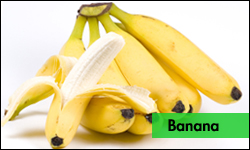Back to > Major Fruits | Minor Fruits | Underutilized Fruits
![]()
 |
||
|
|
1. Ding, Phebe and Ahmad, S.H. and Abd. Razak, Abd. R and M.T.M, Mohamad and Shaari, M. (2007) Plastid Ultrastructure, Chlorophyll Contents and Colour Expression during Ripening of Cavendish Banana (Musa Acuminata ‘Willams at 18°C and 27°C. New Zealand Journal of Crop and Horticulture Science ( 35 ): 201 – 210 .When Cavendish banana (Musa acuminata ‘ William ‘) is ripened at tropical ambient temperature (27°C ) the peel fails to degreen although the pulp has softened . However , the peel will degreen to a yellow colour when the fruit is ripened at 18°C .The inability of the peel to degreen could be because of the retention of thylakoid membranes in the plastids and chlorophyll during the ripening process.A study was carried out to investigate the relationships between plastid ultrastructure , chlorophyll content , and peel colour of Cavendish banana ripened at 18±2°C (C18) and 27 ±2°C (27) . The peel of Cavendish banana underwent complete degreening when the fruit was ripened at a temperature of 18 °C to produce a yellow fruit at ripening stage (RS)6 , after 9 days of treatment. In contrast , bananas exposed to 27°C failed to degreen . By day 5 after ripening initiation , the pulp had softened to eating ripe in those fruit and brown specks appeared on the fruit peel indicating that senescence had begun . Transmission electron microscopy revealed that the grana-thylakoid membranes of peel chromoplasts had iysed by RS 6 in C18 fruit and only 40% of the total chlorophyll content from RS1 was retained . In contrast ,the grana –thylakoid membranes in C27 at day 5 were retained , along with retention of 57% of total chlorophyll content . Total chlorophyll content of C27 fruit correlated significantly with L* , C * and h ° colour values . The higher percentage of total chlorophyll retained in C27 compared with C18 fruit did not fully unmask the existing peel carotenoids thus producing a pale-green fruit.
2. M.T. Ratule 1, A. Osman 1*, N. Saari 1, S.H. Ahmad2. (2007). Microstructure of peel cell wall and selected physico-chemical characteristics of ‘Berangan’ banana (Musa cv. Berangan [AAA]) ripened at high temperature . AsPac J. Mol. Biol. Biotechnol., Vol. 15 (1) : 8-13.Peel of mature-green ‘Berangan’ banana (Musa cv. Berangan AAA) was investigated by scanning and energy filter¬ing transmission electron microscopy. Fruits were ripened at 25ÚC and 37 oC, and micrographs of the fruits were compared at three different stages of ripening namely green, turning yellow and full yellow. Increased of loss of cell wall integrity was exhibited by the fruit ripened at 25 oC as compared to that ripened at 37 oC, especially at turning yellow and full yellow stages because of pectin solubilization. This is supported by a greater percentage decrease on firmness in banana exposed to 25 oC. Transmission micrographs showed empty regions of the middle lamella at 25 oC at turning yellow and full yellow stages. However, a higher linear increase in soluble solids concentration at 25 oC enhanced the turgor loss in the peel. This could have contributed to the loss of firmness at 25 oC that was indicated by the higher linear increase of pulp to peel ratio. Results of this study indicated that 37 oC retains the integrity of cell wall, especially of the middle lamella as compared to 25 oC.
- Englberger, L. 2003. Carotenoid-rich bananas in Micronesia. InfoMusa 12(2): 2–5.
- “FAOSTAT: ProdSTAT: Crops”. Food and Agriculture Organization. 2005.
http://faostat.fao.org/site/567/DesktopDefault.aspx?PageID=567. Retrieved on 09-12-2006. - http://agroforestry.net/tti/Musa-banana-plantain.pdf
- http://www.ctahr.hawaii.edu/nelsons/banana/
- Kepler, A.K., and F.G. Rust. 2005. Bananas and Plantains of French Polynesia. Part I Traditional Non-Fe‘i Bananas: Descriptions, color photographs, status, and possible kinships with Hawai‘i’s ancestral bananas. Part II Color photographs of Western introduced Varieties. Part III Names & Synonyms of Extant and Recently Extirpated Varieties, Tahiti & the Marquesas Islands. Part IV Traditional Non-Fe‘i Banana Varieties, Society and Marquesas Islands: Known Historical Names, Meanings, and Locations dating back to the mid-19th Century. Part V Appendices. Unpublished.
- Lassoudiere, A., 1974. La mosaïque dite a tirets du bananier Poyo en Cote d’ Ivoire. Fruits,. 29: 349-357. Page 4. Int. J. Virol, 3 (2): 96-99.
- Lockhart, B.E. 1986. Occurence of canna yellow mottle virus in North America. Phytopathology 76: 995.
- Nelson, S.C., R.C. Ploetz, and A.K. Kepler. 2006. Musa species (bananas and plantains), ver. 2.2. In: Elevitch, C.R. (ed.). Species Profiles for Pacific Island Agroforestry. Permanent Agriculture Resources (PAR), Hōlualoa, Hawai‘i. <http:// www.traditionaltree.org>
- Olorunda AO, Aworh OC. 1984. Effects of Tal Prolong, a surface coating agent, on the shelf life and quality attributes of plantains. Journal of the Science of Food and Agriculture 35: 573-578.
- Rene Rafael C. Espino, Ph. D., et al, 2000.Banana Production.“Tracing antiquity of banana cultivation in Papua New Guinea”. The Australia & Pacific Science Foundation.http://apscience.org.au/projects/PBF_02_3/pbf_02_3.htm. Retrieved on 2007-09-18
- Yueming Jiang1, , Daryl C. Joyce3, Weibao Jiang4 and Wangjin Lu. 2004. Effects of Chilling Temperatures on Ethylene Binding by Banana Fruit Plant Growth Regulation 43: 109–115, 2004.Kluwer Academic Publishers. Printed in the Netherlands.
